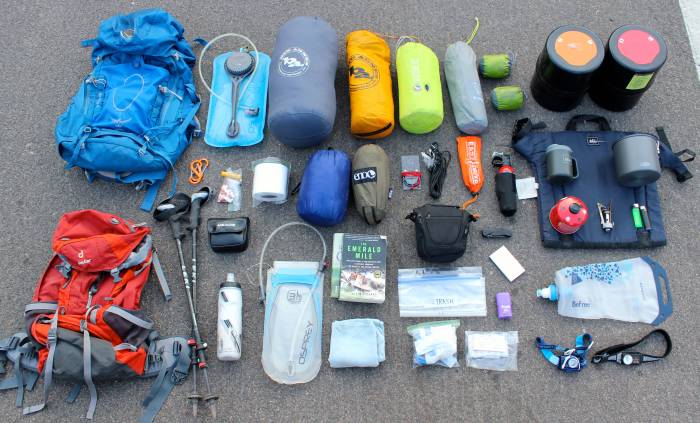Gear, food, and apparel are essential to every backpacking trip, though the specific items vary depending on the individual and their destination. On a recent backpacking trip in Grand Teton National Park, our editor took detailed notes on each item he and his wife chose to bring along.
On August 15, my wife and I set out to backpack 40 miles along the Teton Crest Trail. The trail is one-of-a-kind, paralleling the west side of the Teton mountain range via breathtaking mountain passes and basins. We took four days and three nights to complete the trek, soaking in the views and sleeping in epic locations along the way.
Here’s our comprehensive packing list, categorized by gear, food, and apparel. Hopefully, it will help you when you’re packing for your next backpacking trip. It’s worth noting that my wife and I aren’t ultralight hikers and opted for extra comforts this time around to help us enjoy our trip.
The Gear We Brought on the Teton Crest Trail
Backpacks: Osprey Atmos 65 and Jansport Katahdin 70
I’ve owned my Atmos 65 pack since 2011. It’s comfortable, has plenty of features, and has enough capacity for me to carry most of the bigger gear items. I always keep the pack cover (sold separately) in the outer stretch pocket.
After struggling to fit one of the bear canisters in my wife’s 34-liter Deuter backpack (pictured above), we quickly switched her to our only other pack, Jansport’s Katahdin 70. It’s large and heavy but performed well on our trek.

Water Bladders: Osprey 3-Liter Reservoirs
Water Bottle: Camelbak Podium Big Chill 21oz Insulated Bottle
Tent: Big Agnes Tiger Wall UL2
Sleeping Pad: Big Agnes Q-Core SLX Insulated Double
Sleeping Bag: Big Agnes Sentinel 30 Double
Blanket: Blue Ridge Home Fashions Packable Oversized Down Throw
Pillows: Sea to Summit Aeros Pillow Premium (Large)

Camp Chairs: Helinox Chair Zero and REI Co-op Trail Chair
Rain Tarp: ENO ProFly Rain Tarp

Bear Canisters: Sabre Frontiersman Bear Safe Container
Bear Spray: Counter Assault Bear Deterrent Spray
Water Filter: Katadyn Gravity BeFree Water Filtration System – 3 liters
Stove: MSR PocketRocket Stove
Propane: MSR IsoPro Canister Fuel
Lighters: BIC Classic Lighter
Pot: GSI Outdoors Halulite 1.8-liter Ultralight Boiler Pot

Sporks: Humangear GoBites Uno Spork
Coffee Mug: REI Co-op Recycled Camp Mug (20 fl. oz.)
Towel: Next Adventure Microfiber Camp Towel
Multitool: Leatherman Crater C33SX
Trekking Poles: Leki Makalu Carbon Ultralight
Headlamps: Ledlenser SEO 7R and UCO Air
Binoculars: Meade 10×25 Binoculars
Portable Charger: myCharge RAZOR PLUS USB Portable Power Bank
Extra Tent Stakes: Wildish Aluminum Tent Stakes
Rope: Miscellaneous
Compass: Suunto M-5 SK
Camera: Canon EOS Rebel T3i

First-Aid Kit: Miscellaneous
Blister Treatment: Body Glide Foot Anti Blister Balm
Toilet Paper: Scott 1000 Septic Safe Toilet Paper
Body Wipes: Huggies Natural Care Fragrance-Free Wipes
Trash Bag: Gallon Ziplock Freezer Bags
Chapstick: Burt’s Bees Beeswax Lip Balm
Medicine: Ibuprofen and Equate Headache Relief
S-Biners: Nite Ize S-Biner #4
Sandals: Chaco Z/2 Cloud
Books: “The Emerald Mile” and Amazon Kindle E-Reader
The Food We Brought
Breakfast: Quaker Instant Oatmeal Protein and Alpine Start Original Blend Instant Coffee
Snacks: CLIF Bars, Peanut Butter Crackers, Sunbelt Bakery Oats & Honey Bars, Trail Mix, Gatorade Mix, Fruit
Lunch: Peanut Butter and Honey Pita Sandwiches, Dill Pickle Chips, Fruit, Snickers
Dinner: Omeals and Tea

My Trail Apparel
Shirt: MtnLogic
Shorts: Lululemon Surge 7-Inch Shorts
Socks: Smartwool PhD Outdoor Light Crew Socks, Darn Tough Dashes Crew Light Socks, Stance Warm Socks
Shoes: Merrell MQM Flex Mid Waterproof Boots
Warm Jacket: The North Face Ventrix Hoodie

Sweatpants: Showers Pass Track Pants
Rain Jacket: Marmot Eclipse Jacket
Miscellaneous Apparel: Mountain Hardwear Gloves, Flowfold Beanie, BUFF, Gap Long-Sleeved Shirt, ExOfficio Boxer Briefs, Columbia Running Hat, Wiley X Hudson Sunglasses
My Wife’s Trail Apparel
Shirts: Black Diamond S/S Block Tee and Under Armour Athletic T-Shirt
Sports Bra: Under Armour Seamless Plunge
Shorts & Leggings: Reebok Athletic Shorts and Leggings
Socks: Smartwool Socks, Cotton Ankle-High Socks From Target

Shoes: Merrell Eventyr Bluff Waterproof Boots
Warm Jacket: The North Face Ventrix jacket
Sweatpants: Under Armour sweatpants
Rain Jacket: Marmot Minimalist Waterproof Jacket

















